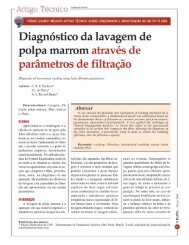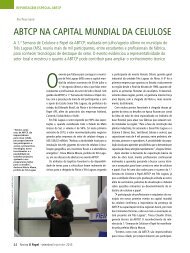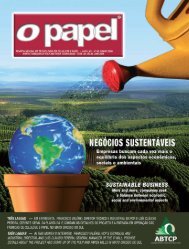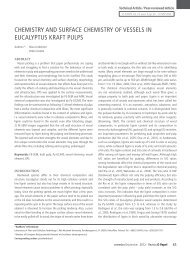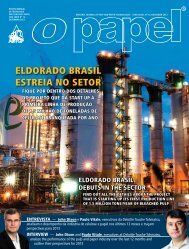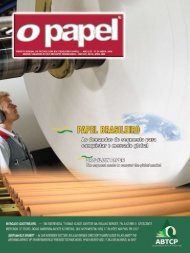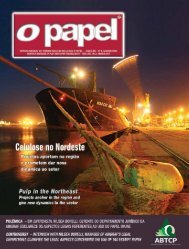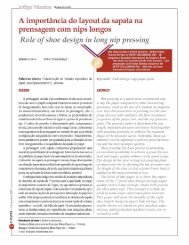You also want an ePaper? Increase the reach of your titles
YUMPU automatically turns print PDFs into web optimized ePapers that Google loves.
fifth objective focuses on training of human resources.<br />
With a better technical and managerial background<br />
on the part of human resources, we expect the<br />
sector to reach greater maturity in the future. For<br />
such, the initiative adopted will be to insert the pulp<br />
and paper sector in the work that is already being<br />
carried out by the government in the education area,<br />
offering exchange programs between federal public<br />
universities and universities abroad through the<br />
Science without Frontiers Program and strengthening<br />
of the “S” system (Sesc, Senac, Senai and Sesi).<br />
O <strong>Papel</strong> – What measures are foreseen on the<br />
sectorial agenda so that these five macro-objectives<br />
can be achieved<br />
Da Hora – The measures proposed still depend on<br />
approval from CNDI, which is expected to analyze them<br />
in a meeting scheduled for early August. What I can say<br />
at the moment is that there exist specific measures for<br />
the pulp segment and others for the paper segment that<br />
differ significantly in nature. What is important to say<br />
is that in both cases, what is being pursued is to solve<br />
critical short-term issues (tax, regulatory and trade<br />
protection), so that we can implement better structured<br />
solutions for matters that affect the competitiveness<br />
of sectors in the long-term (logistics, governance,<br />
innovation and human resources training).<br />
O <strong>Papel</strong> – What are your expectations in terms of<br />
executing these measures<br />
Da Hora – Personally, what I expect is that the<br />
measures and actions proposed in the sectorial agenda<br />
will be carried out as planned, in accordance with what<br />
will be endorsed by CNDI. And I believe that this will<br />
in fact occur, since initiatives were outlined for each<br />
action nucleus and, for each initiative, one person was<br />
attributed responsibility, including a government body<br />
and the person responsible in it. The final deadline for<br />
the measures listed in the plan to be implemented is<br />
the end of 2014. However, some goals associated to<br />
reducing taxes and regulatory issues are clearly shortterm,<br />
and shall be implemented yet in 2012. In turn,<br />
measures linked to infrastructure and innovation will<br />
require more time to be put into practice, due to their<br />
complexity.<br />
O <strong>Papel</strong> – In your opinion, what are the greatest<br />
challenges to be overcome by the pulp industry<br />
Da Hora – In the pulp segment, the concern is<br />
more focused on maintaining the competitiveness<br />
already conquered over the years. The market<br />
space that Brazil’s industry conquered, which is<br />
mainly due to the high forest productivity, access<br />
to relatively cheap and large amounts of land and<br />
forest research done over the past decades, made<br />
the country become a global player. However, these<br />
advantages are diminishing day by day, land prices<br />
are already at a higher level, while genetic and<br />
technological research have also been implemented<br />
in other countries, such as Chile and Indonesia.<br />
The productivity of these countries is not yet at par<br />
with Brazil, but can already be considered quite<br />
high. Therefore, what Brazil needs to seek today is<br />
a second wave of competitiveness. This has certain<br />
implications, particularly in relation to demand. If<br />
before our main market was Europe, at present the<br />
main consumer of our pulp is China, which fact<br />
changes things a lot in terms of logistics. In addition<br />
to a longer route, prices are lower, profit margins are<br />
lower and there exists considerable concentration<br />
in that market. Chile, for example, becomes very<br />
competitive since it is located on the Pacific coast, as<br />
does Indonesia, given its proximity to China. As such,<br />
it is necessary to seek new ways of competing. This<br />
is where structural issues, such as improving logistics<br />
and innovative ways of adding value to wood, lead<br />
us to consider pulp mills as biorefineries in the future.<br />
O <strong>Papel</strong> – Looking at the paper industry, what are<br />
the main obstacles to be faced<br />
Da Hora – The paper sector needs to focus on<br />
developing the internal market. At present, Brazilian<br />
companies compete with foreign companies,<br />
particularly, Chinese. And in order for domestic<br />
players to be competitive in the internal market, it<br />
is necessary to think about expanding and improving<br />
the size of our industry, which lags in relation to<br />
others doing business around the world. The tax<br />
issue is also much stronger in the paper sector than<br />
in the pulp sector, as are logistics matters. Overall,<br />
paper producers need to be located closer to their<br />
consumer markets. Due to the country’s dimensions,<br />
logistics in Brazil is a bit more complicated and<br />
expensive. Therefore, the challenges of the paper<br />
sector, in a nutshell, are increasing the size of<br />
companies and better logistics organization. I would<br />
also include increasing domestic consumption, which<br />
would also act as a major lever for new projects. •<br />
“In the pulp<br />
segment, the<br />
concern is more<br />
focused on<br />
maintaining the<br />
competitiveness<br />
already<br />
conquered over<br />
the years based<br />
on comparative<br />
advantages.<br />
However, such<br />
advantages are<br />
diminishing day<br />
by day”<br />
julho/July 2012 - <strong>Revista</strong> O <strong>Papel</strong><br />
55



